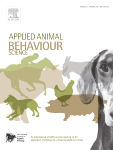Document type : Scientific article published in Applied Animal Behaviour Science
Authors: Guro Vasdal, Karianne Muri, Solveig Marie Stubsjøen, Randi Oppermann Moe, Kathe Kittelsen
Preview: Animal welfare must be considered from a broad perspective, including positive emotional states. Qualitative behaviour assessment (QBA) is one of few scientific methods to assess positive emotional states of animals. QBA for poultry is included in the Welfare Quality® protocol, but has not been validated for laying hens. The aim of this study was to investigate the dimensionality of QBA for laying hens and the associations between the main principal components of QBA and selected animal-based welfare measures. A total of 22 flocks were visited between the age of 70-76 weeks. All flocks consisted of approximately 7500 white-strain hens (Dekalb White, n = 11; Lohman LSL, n = 11) with intact beaks, housed in indoor multi-tiered aviary systems. Each flock was assessed using a fixed list of QBA terms, in addition to scoring of plumage and fear, and collection of mortality data. QBA was analysed using principal component analysis (PCA), revealing three main dimensions that can be recognised from QBA in other species. These were labelled mood (PC1), alertness (PC2) and arousal (PC3), and explained 50.8%, 19.7%, and 12.0% of the variance, respectively (82.5% overall). There were no associations between the QBA scores and plumage score, fearfulness, or mortality in the flocks. The lack of significant associations might be due to a limited sample size, a homogenous study population or the inherent motivation in hens to suppress signs of weakness or sickness. QBA can nevertheless become an important tool for measuring emotional expressions in laying hens. However, the method needs further validation.






